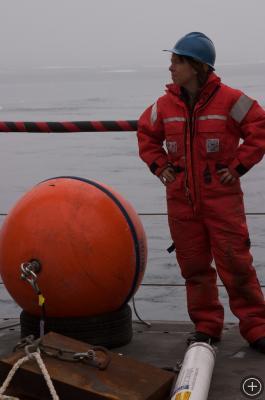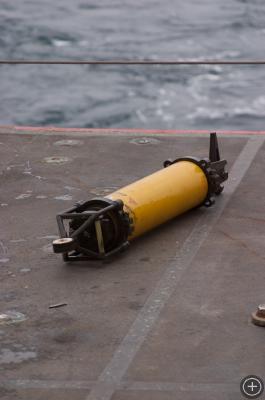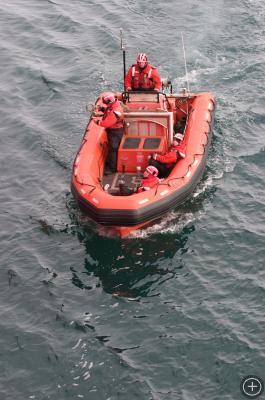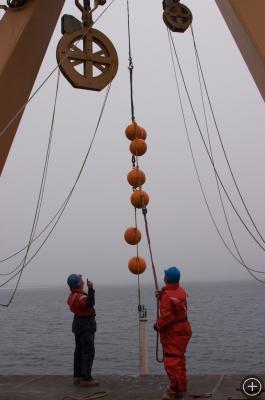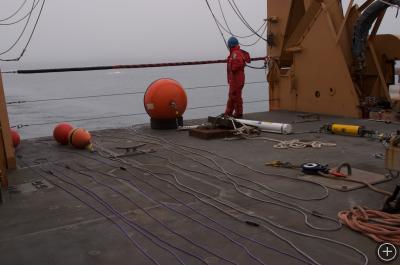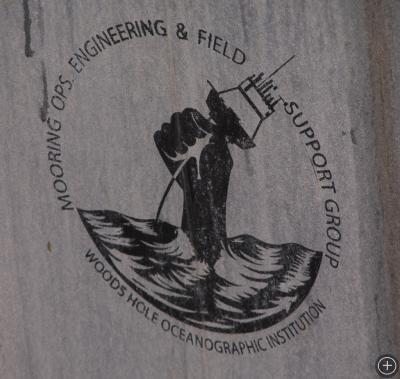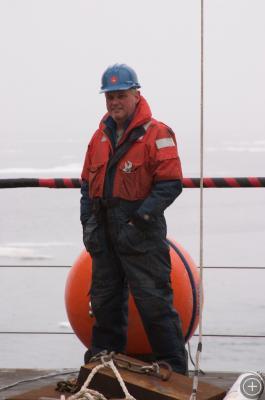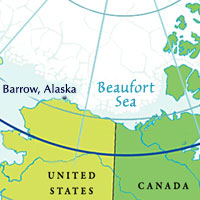Ears of the Deep, Part IV: Recovering and Deploying Moorings
ABOARD THE USCGC HEALY, ON THE BEAUFORT SEA– My last dispatch discussed the work of scientist Kate Stafford, who uses sets of acoustic sensors called hydrophone arrays to listen to the sounds of whales, dolphins, and other marine life. These sensors are placed on moorings, and the subject of today’s dispatch is recovering and deploying the moorings.
Recovering a mooring of any significant size essentially amounts to getting it to the surface and picking it up with a ship using a crane. Recall that one of the key items contained on the mooring is the acoustic release. The release is essentially a chain link that opens up when it receives a particular acoustic waveform placed into the water.
Many, such as the one Kate is using, also send out a beacon or “ping” when acoustically interrogated. So, to recover a mooring, one steers the ship to the GPS location closest to where the mooring was deployed, places the appropriate set of tones in the water which will induce the release to start sending beacon tones and release the mooring from the anchor, and then home in on the mooring’s location using the beacon. At this point, the mooring can be reached at the surface, and only the anchor remains at the bottom.
To physically perform the recovery on a big ship such as Healy, a rigid inflatable boat (RIB) is dispatched from the recovering ship to find the top float(s). Of course, if the top float(s) ascended under a blanket of sea ice, there are more details to handle, but we didn’t have to deal with this particular problem on this cruise. We avoided it by electing not to recover a particular mooring on the first day and coming back later to recover it (when the ice had moved on).
The small boat will locate the mooring by looking for the float(s). Floats are typically painted in colors or contained within painted containers that are relatively easy to see, even in poor weather conditions (e.g., optic yellow or orange). One of the more common float arrangements is to strap together a collection of glass spheres each of which provides a certain amount of buoyancy and can resist the high pressures of submergence at depth. Such spheres can also be used to house instruments. Floats for less extreme depths, made of plastic or foam materials, can be used for applications involving less pressure (foam compresses at high pressure and loses its buoyancy; glass does not). In some applications the float is allowed to bob around on the water surface (called a “surface expression”), but in cold areas such as the arctic this can be a problem because floating ice can damage a float or, worse, carry off the entire mooring.
Once the small boat operators get a hold of the recovery line attached to the float, they maneuver to the stern of the recovering ship and connect the recovery line to the ship’s crane line. At this point, the small boat gets out of the way so the ship’s mooring crew on deck can recover the mooring. This is accomplished by winching in the line and moving the A-frame, which is a large metal inverted-U-shaped hoist attached to the ship. It is operated by hydraulic lifters and is used to position moorings or other equipment beyond the stern of the ship over the water.
Deploying a mooring, or re-deploying a mooring, involves placing the mooring into the water top-to-bottom (there are other ways, but all the moorings deployed on this cruise were done top-to-bottom), with the recovery line first and anchor last.
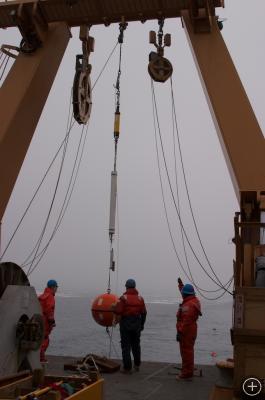
Mooring with acoustic release, audio recorder, CTD and float ready for deployment; the recovery line and its floats are already in the water.
If the mooring is sufficiently small (like Kate’s) it is possible to lay the entire mooring out on deck ahead of time.
First, the top float(s) are placed in the water, then the instrument(s), then any additional floats and finally the anchor. The anchor is placed in the water by careful use of the ship’s crane. It may be partially lowered into the water and released at just the right time so as to land on the ocean floor at the desired location. After the anchor is released, it sinks to the bottom pulling the rest of the mooring along with it. It is thus possible to see the primary float(s) rapidly approaching the stern of the ship until they are pulled below the surface.
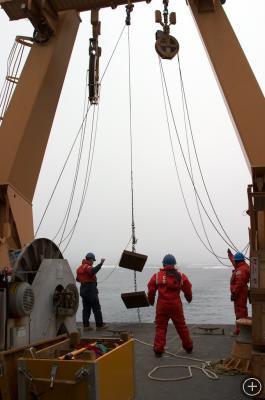
Anchor weights are deployed by the winch. John holds a line that when pulled releases the weights from the crane.
Although the recovery and deployment of moorings may seem conceptually simple, there are many details to get just right. Errors in mooring design or deployment execution could mean a costly waste of ship time, a loss of data or equipment, or possible injury to the scientists or crew. This is true of most heavy work on ships, but is exacerbated when working in the Arctic due to the hostile conditions. For this set of scientists and crew, mooring recovery and deployment is conducted by the Woods Hole Oceanographic Institution’s Mooring Operations Engineering and Field Support Group, led here by John Kemp, a legend in the “mooring community.”
Although I personally lack the level of sea experience this crew has by many orders of magnitude, I have been around ships and small boats for most of my life, and I can appreciate a virtuoso at getting work done at sea, and John is definitely one.
(Thanks to Dale Chayes (LDEO) and Kate Stafford (APL) for helpful comments on this article).

 No comments
No comments 